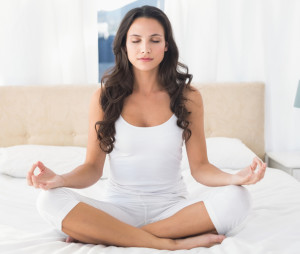How to De-Stress: 4 Proven Tactics
The modern world is filled with stressful situations. Fortunately, there are just as many ways to de-stress.
Looking for a way—or ways—to fight off stress? There’s no way to completely avoid it, so your best bet is to learn how to de-stress. Fortunately, there are methods and activities you can try in your own home. Here, we guide you toward four proven ways to help you handle pressure.
How to De-Stress #1: Exercise
If you want to reduce stress, there’s no question that a healthy body goes hand-in-hand with a healthy mind. If you’re not one for physical activity, there’s good news for you. Research suggests that you don’t have to do much in order to benefit from the de-stressing effects of exercise.

Regular exercise—which can be as simple as a jog at your local high school track or a regular brisk walk around your neighborhood—is one of the simplest but most important ways to de-stress.
If you can handle only a brisk 10-minute walk, that may be enough to provide some relief. You can always pick up the pace or extend your walks as you start to feel more energized. (See our post “The Benefits of Walking.”)
Choose an activity you enjoy, and try to find a buddy to do it with you. This will make it more fun, provide motivation to keep it up, and have the added de-stressing benefit of socializing with someone. To really benefit from the de-stressing effects of exercise, you need to do it regularly, at least three to five times a week.
How to De-Stress #2: Meditation for Stress Reduction
It’s becoming an increasingly popular way to de-stress, and with good reason. There are many forms of meditation, and one of the most popular is known as mindfulness meditation. Exercises in this category typically are quite simple. For example:

Mindfulness meditation akes just quiet and focus, and is an easy path for those who set out to learn how to de-stress.
1. Find somewhere quiet and comfortable to sit.
2. Close your eyes and take deep, slow breaths.
3. Gently, pay attention to your breath as you breathe in and out.
4. If you’re distracted by a noise, feeling, or thought, simply acknowledge it without judgment. Naming it in your mind helps. Then gently bring your attention back to your breathing.
The key to mindfulness is to be gentle with yourself. It’s normal for your mind to wander or for you to become distracted. In fact, gently bringing your mind back to your breathing is the practice. In other words, without your mind wandering or becoming distracted there is no practice. So, be kind to yourself. Don’t get frustrated or discouraged when your mind wanders, and bring yourself back to your breathing gently, without force.
How to De-Stress #3: Deep Breathing
Everyone breathes, of course, but there are specific breathing exercises that can help as you learn how to de-stress. As with meditation, there is no need to get fancy.
The following deep breathing exercise is so deceptively simple people don’t believe it can possibly be helpful, but if you do it regularly, you will notice a difference in your stress level. It’s called “4-7-8 deep breathing”:

How to de-stress? Meditation is one proven way to take off the edge. Yoga also emphasizes breathing exercises; see our post Yoga for Beginners: How It Benefits Your Body, Mind, and Spirit” for more.
1. Inhale slowly through your nose to the count of 4. Be sure to fill your lungs and feel your belly expand.
2. Hold your breath while you count slowly to 7.
3. Slowly breathe out through your mouth to a slow count of 8, making a whooshing sound.
4. Without pausing, start breathing in again through your nose to the count of 4.
5. Repeat several times until you feel better. Don’t stop if you don’t feel better immediately, as it can take few minutes before you feel the effects.
How to De-Stress #4: Let It All Out
Stress tends to build if we don’t find an outlet for it. For some people, physical activity like exercise is all they need to release their frustrations, but many people don’t feel fully unburdened unless they verbalize it. Try talking your problems and frustrations out with a friend, family member, member of the clergy, or therapist.
If you’re looking to vent rather than to solicit advice, it’s a good idea to let the person you’re talking to know that in advance. That way, there are no hurt feelings if you choose not to do what they suggest.
Some people get a lot of benefit by journaling. This has the advantage of letting you be completely free and honest with your feelings, since no one has to read what you write.

Whether visiting a counselor or meeting with a trusted friend, “letting it out” is a time-tested way to de-stress.
For related reading, please see these posts:
- “Yoga for Beginners: How It Benefits Your Mind, Body, and Spirit“
- “Stress Reduction Is Blood Pressure Reduction“
- “Stress Headaches, Cluster Headaches, Migraines… Treatments Hinge on Which Headache Type You Have“
Originally published in 2016, this post is regularly updated.


 SOCIAL ANXIETY
SOCIAL ANXIETY  Look Beyond the Scale
Look Beyond the Scale  Study Suggests That Mental Health Disorders Affect One Out of Two People by Age 75
Study Suggests That Mental Health Disorders Affect One Out of Two People by Age 75 
Stressed and anxious? Get out and exercise—even a walk for 20 minutes will help you learn how to de-stress.
© Fizkes | Dreamstime